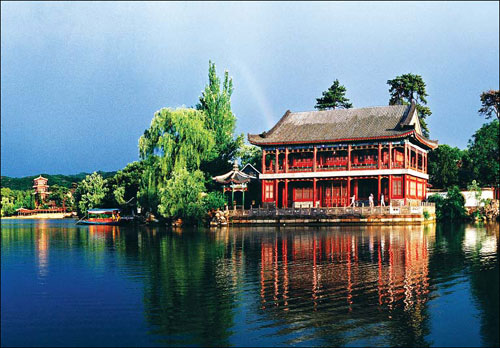|
|

The Zhongdu grasslands in Zhangbei county, Hebei province, will host the InMusic Festival that opens today. Photos provided to China Daily |
|

The Chengde Imperial Summer Resort was added to the UN's World Heritage List in 1994 along with eight nearby temples. |
600m yuan for work on world's largest complex
The world's largest imperial garden complex is expected to receive 600 million yuan ($94.2 million) for conservation from the Chinese government during the 12th Five-Year Plan (2011-2015) period, according to a conservation official in the city of Chengde in North China's Hebei province.
A 290 million conservation fund, nearly half of the total, has already been earmarked for the Chengde Imperial Summer Resort and eight adjacent imperial temples, the head of the conservation effort told China Daily late last month.
In addition to conservation efforts well under way, work on another 52 projects has begun this year, mainly dedicated to heritage conservation, fire safety and site protection, he said.
The resort will remain open to visitors as the work continues, the official added.
Started in 2010, the conservation initiative is another major move by the central government following similar efforts at the Potala Palace in Tibet and the Great Wall near Beijing.
The large investment tops the list of all conservation efforts nationwide since the founding of the People's Republic of China in 1949.
The program is expected to last three to five years.
The summer resort, built between 1703 and 1792 during the reign of three emperors in the Qing Dynasty (1644-1911), is the largest extant complex of imperial palaces and gardens in the world.
Covering 5.64 million square meters, it is around two times the size of the Summer Palace and eight times the size of Beihai Park, both of them imperial gardens in Beijing.
Quite different from conventional Chinese gardens, the resort is built around a large mountain that accounts for more than 80 percent of its total acreage.
The mountain helps keep temperatures in the resort 3 to 4 degrees lower than the nearby terrain.
Because of its vast and rich collection of traditional Chinese landscapes and architecture, the resort was added to the UN's World Heritage List in 1994 together with eight nearby temples that embody elements of Mongolian, Tibetan and Uygur architecture.
Built in the same period as the resort, the temples - which have a combined area of 400,000 square meters - once served as places of worship for leaders of Mongolian, Tibetan, and Uygur ethnic groups when they paid visits to the Qing emperors, especially the first several, who usually spent the summer in the resort.
With such resources, Chengde was listed among China's first group of historic and cultural cities in 1982.
Tourism has since been a pillar industry in the city less than 200 kilometers north of Beijing, said a local tourism official.
Official statistics show that the industry generated 12.6 billion yuan in revenue in 2011, accounting for more than 11 percent of the city's GDP.
Contact the writers at liuxiang@chinadaily.com.cn and lifusheng@chinadaily.com.cn
(China Daily 07/27/2012 page24) |